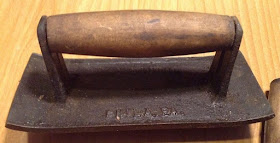 |
| W.S. Godwin edger and groover |
W.S. Godwin & Company was making cement worker's tools in Philadelphia in 1898. Godwin also sold asphalt tools and machinery beginning in 1899 from New York City. While in Philadelphia, he invented a brick and block molding machine, and filed for a US patent in 27 Jan. 1903.
He closed the Philadelphia business and moved to New York City to manufacture the molding machine with a partner, as American Block Press Company of Brooklyn, NY. In a 1904 professional directory, he was listed as general manager of that business. Godwin recommended the machine for asphalt paving bricks. The most famous American street still paved with asphalt bricks is Monument Avenue in Richmond, VA, paved from 1907 to 1910.
American Block Press Co. either failed or was renamed, because Godwin sold paving machinery from New York as W.S. Godwin for about 10 more years. By 1918, he had left New York, and was chief engineer for the International Steel Tie Co. of Cleveland, Ohio. Godwin continued to work on inventions for concrete paving.
 By 1920, Godwin had moved to Baltimore, and as W.S. Godwin Company, was making steel paving guards at 2111 Garrison Ave. In 1924 W.S. Godwin was located at W. Race and McComas Sts., Baltimore. Today, 222 W. Race St. in Baltimore houses Schuster Concrete, commercial and industrial construction. W.S. Godwin's steel paving guards catalog is on Archive.org.
By 1920, Godwin had moved to Baltimore, and as W.S. Godwin Company, was making steel paving guards at 2111 Garrison Ave. In 1924 W.S. Godwin was located at W. Race and McComas Sts., Baltimore. Today, 222 W. Race St. in Baltimore houses Schuster Concrete, commercial and industrial construction. W.S. Godwin's steel paving guards catalog is on Archive.org.Unlike his fellow business owners, William S. Godwin did not put down roots anywhere, and lived in hotels or apartments. He married late, in 1912, to Christine Keller of Brooklyn, and they had 1 child.
William S. Godwin had at least 9 patents relating to paving streets and around railroad and streetcar tracks. All are in his name as the inventor, but the last 3 are not signed by him and are after his death in 1944.
Molding-machine, publication date 28 Feb. 1905
Paving-guard, publication date Dec 9, 1919
Paved railway, publication date Aug 25, 1925
Paved or similar railway structure, publication date May 6, 1930
Curb guard and facing, publication date May 22, 1934
Shield and dowel assembly, publication date Dec 23, 1941
Dowel supporting assembly [for concrete road joints], publication date Jan 25, 1949
Road joint, publication date Apr 14, 1953
Dowel apparatus for paving joints, publication date Oct 30, 1956
William S. Godwin also wrote a poem which was printed in asphalt paving publications in 1901 and 1908, Asphaltina's Soliloquy.
 |
| W.S. Godwin groover |
 |
| W.S. Godwin bronze indent roller |
